There's a moment of nervousness when you hear your kids shout, “Hey mom, look what we can do!”, especially when it's on a trampoline. One thing you don’t want to have to worry about while the kids are playing is how much weight the trampoline can hold. You need to understand the trampoline weight limits.

Trampolines make for hours of weightless fun, of bouncing and jumping and performing the latest acrobatic maneuver. It’s a great form of exercise for young and old. But before anyone tries out the next full twist or somersault, there are a few things you really should know.
In this article, we will take a look at the weight limits of trampolines, exactly what they mean, and why it's important to know the trampoline weight capacity and overall, how much your trampoline can hold.
What exactly does trampoline weight limit mean?
The trampoline weight limit refers to the amount of weight a trampoline can support. It is the total weight of the person or persons that should not be exceeded to safely enjoy bouncing on a trampoline. Exceeding this weight limit can damage your trampoline and increases the risk of injury.
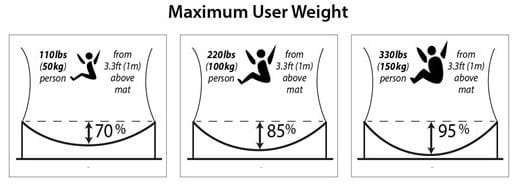
Let’s look a bit deeper into the importance of safety issues that could be involved with exceeding the weight limits as well as the wear and tear on the trampoline itself.
Why is it important to know the weight limit on a trampoline?
Safety – It’s important to know the weight limit of the trampoline basically as a safety feature. Weight limits are meant to advise you on how much weight the trampoline can hold safely and what the trampoline can endure before the probability of a malfunction. A trampoline frame folding up or a jumping pad ripping can result in injury.
Durability – When you make an investment in a trampoline you want it to last for years. Exceeding the weight limit can create undue stress on the springs, mat, and frame of the trampoline, reducing its overall lifespan.
Other – There’s another reason to know the weight limit of a trampoline and that's knowing that kids will test things to their absolute breaking limit. If five friends show up, they are going to try and get everybody on it. Knowing the weight capacity and averaging the weight of friends that show up can give you an idea of what level of monitoring needs to take place.
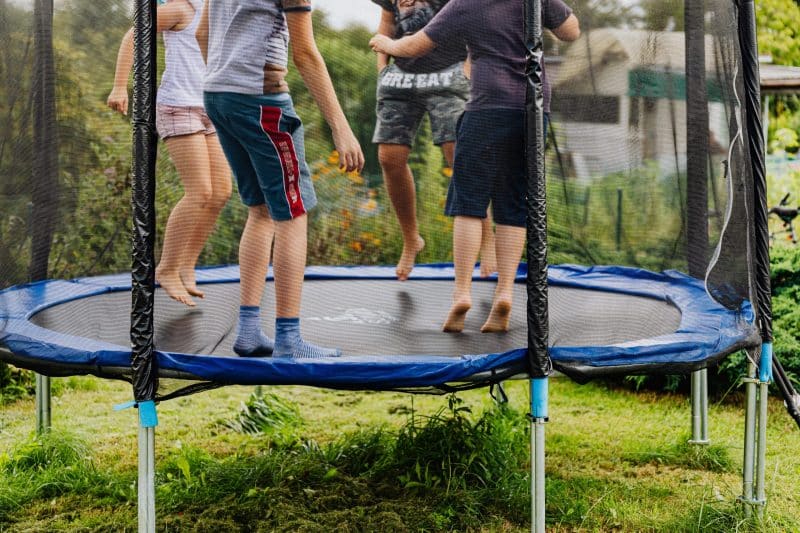
You really should take a moment before running out and grabbing a trampoline to mentally count the kids that come over to your backyard, and the adults who will want to see if they can still do a backflip, or if you just want to get on the trampoline with your kids. Considering all the possibilities the weight limit becomes an essential piece of information.
What determines trampoline weight capacity?
A combination of factors goes into determining the weight capacity of a trampoline. Elements such as springs, mats, frames, and overall size. Determining the weight of a trampoline is important before purchase to make sure you’re getting the safest trampoline for your family to enjoy.

Springs – Springs are possibly the most responsible for the overall weight limit of a trampoline. The longer the length of the spring the more the bounce, but they would have a lower weight capacity than a shorter spring would offer. So basically, the shorter the spring the more weight capacity your trampoline would have.
The number of springs will also determine how much weight a trampoline can hold. The bottom line here is the more springs there are the greater the weight capacity of the trampoline.
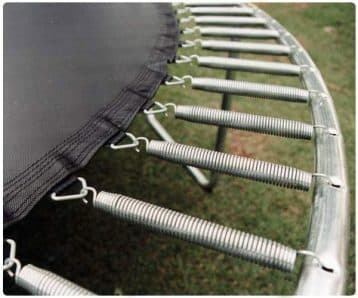
Frame – When you get down to what determines the weight capacity of a trampoline, the frame is going to be a component that you will need to give an extra bit of attention to. It won’t matter how many springs you have or the size of them if the frame won't take the pressure.
Durability, sturdiness, and what material the frame is actually made of can help you determine if a trampoline is going to hold up under a siege of kids going for a group bounce. You will want to look at how the frame pieces together, along with determining if it's a rust-proof material and the thickness of the tubing.

Mat – The mat or jumping pad as it is sometimes called is the centerpiece of the weight capacity puzzle. When you’re looking at the mat you will want to take notice of the weaving of the mat itself. You would be looking for a tighter weave, with extra stitching around the edges, and extra reinforced stitching around the eyelets where the springs attach. And last but not least the thickness of the jumping pad in part determines the weight capacity of a trampoline.
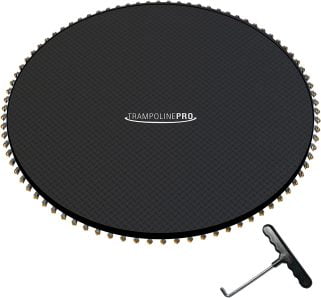
Size – The size of the trampoline will indicate the weight capacity of the trampoline as well. A general rule of thumb is that the smaller trampoline the lower the weight capacity. The overall weight distribution of a larger jumping area equates to a higher trampoline weight capacity.
Style – The style or shape can also be an element in determining the overall weight capacity of a trampoline. The four styles of trampolines you could choose from are round, oval, square, and rectangular. In general, the frame that offers the highest weight capacity out of the four is the rectangular frame.
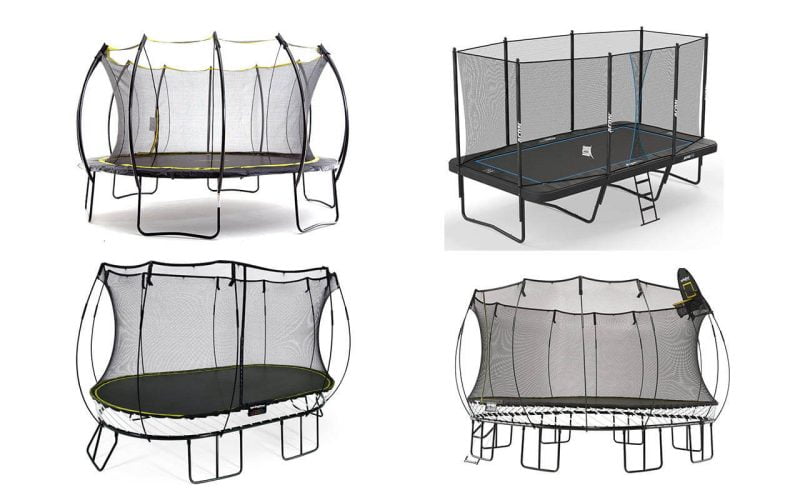
How do size and style influence how much weight a trampoline can hold?
Why size and style influence how much weight a trampoline can hold can be described in two words—weight displacement. Also, if there was a general rule it would be the larger the trampoline the higher the weight limit. There are exceptions to the rule.
The second rule is how the weight is distributed over the entire jumping pad or is centrally located in the immediate area of the jumper. For example, round trampolines distribute weight over the entire frame and through all the springs.
Trampolines with lower weight capacities should be limited to one single person that falls within the suggested weight limit. Trampolines with max weight capacities will allow multiple jumpers, but again the weight capacity should for safety's sake be adhered to as closely as possible.
Styles of trampolines
- Round
Round trampolines can range anywhere from a toddler-size trampoline for a small backyard to a huge 16 ft behemoth that would require an equally large yard.
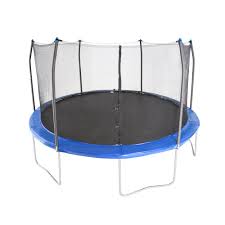
- Rectangle
Rectangle trampolines can range all the way up to an Olympic size of 17 ft. jumping pad. This is a versatile shape that can accommodate weekend bouncers on up to an Olympic hopeful. The Olympic trampoline might be overkill for the backyard play area, but the size might be just right for your kids and all their friends.
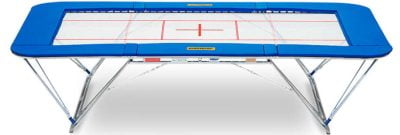
- Rebounders Fitness
The rebounders are small round one-person trampolines used for rebound exercises. Small and compact and has a surprising weight limit of up to 400 lbs on some models.
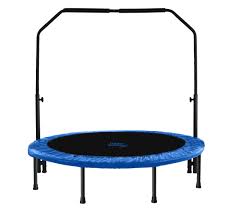
- Square
Square trampolines are made for those who want to experience a high bounce and more jumping pad area. Quality bounce, larger are for tricks, and the ability to jump anywhere on the jumping pad are some of the reasons you might be influenced to go for a square-shaped trampoline.
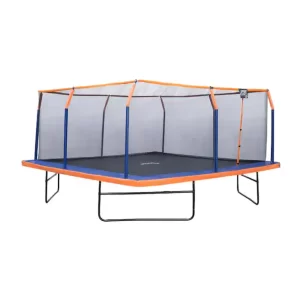
- Octagonal
Step into the octagon if you want to experience a different type of bounce. The shape of the octagon trampoline creates a different jumping experience and is preferred by choosy jumpers.
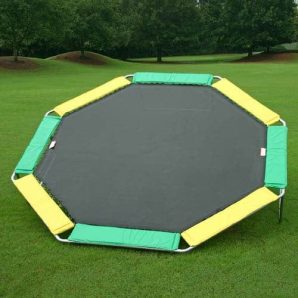
FAQ’s
Is trampoline weight limit per person or total?
The trampoline weight limit is actually both. Some trampolines are rated by a single person's weight, while others are rated by the max weight capacity it can hold. Some brands will have put their trampolines through testing procedures to determine their breaking point, then the maximum suggested weight will be mentioned.
Can you be too heavy for a trampoline?
Yes, you can be too heavy for a trampoline, but it would be because of the max weight capacity of the trampoline. With that being said, you can find trampolines with a max weight of 1500 lbs, so don't fret.
What is the weight limit for a 14 ft trampoline?
The weight limit of a 14 ft trampoline is between 350 lbs to 475 lbs, generally. Now, in that range are considerations of shape and style and materials and springs used and that's what will determine the weight capacity. There are kids trampolines that have a max capacity weight of 960 lbs., so there are exceptions to the rule.





No Comments